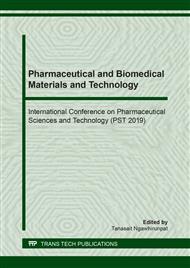p.130
p.139
p.145
p.151
p.157
p.163
p.169
p.175
p.181
Physical Stability of Astaxanthin from Haematococcus pluvialis Loaded in Micromeulsion as a Cosmetic Ingredient for Melanogenesis Inhibition
Abstract:
In this study, astaxanthin (ASTA), with potential anti-tyrosinase and anti-melanin synthesis in melanoma cells (B16F10) was developed as a cosmetic ingredient in the form of microemulsions (MEs). The results showed that ASTA (1 mg/mL) had no toxic effects on melanoma cells and it exhibited high potential for reduction of tyrosinase and melanin content, representing 80.57% and 75.86%, respectively. However, the use of ASTA is limited due to its low stability resulting from its decomposition under light, heat, and oxygen. In order to overcome this drawback, ASTA was encapsulated within ME. ASTA-MEs, consisting of 0.5% w/w of ASTA, oil, surfactant and water, were prepared using titration method.The effect of IPM concentration into microemulsions were investigated at 10 % w/w (ASTA-ME1) and 20% w/w (ASTA-ME2). The physical stability after accelerated condition of all the formulations was also investigated. The results indicated that a thermodynamically stable of microemulsion could improve the physical stability of ASTA. Nonetheless, the oil concentration had a slight influence on the physical stability of ASTA-ME1 and ASTA-ME2. In conclusion, nanoencapsulation can improve the physical stability of pigment extract to be used as a cosmetic ingredient in skin brightening products.
Info:
Periodical:
Pages:
157-162
Citation:
Online since:
August 2019
Keywords:
Price:
Сopyright:
© 2019 Trans Tech Publications Ltd. All Rights Reserved
Share:
Citation:


